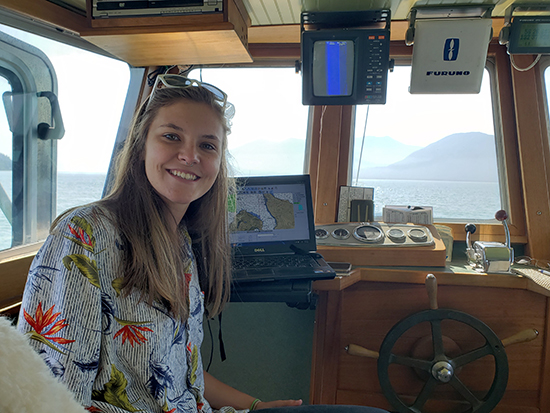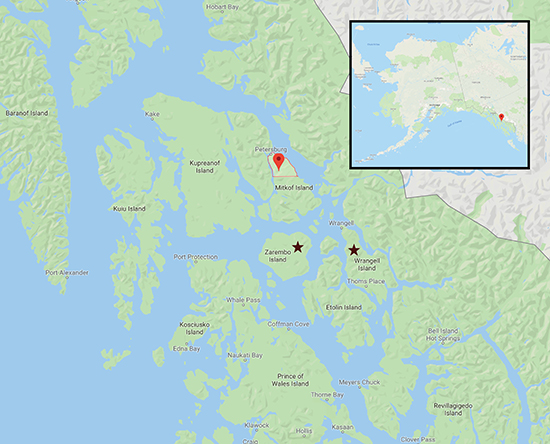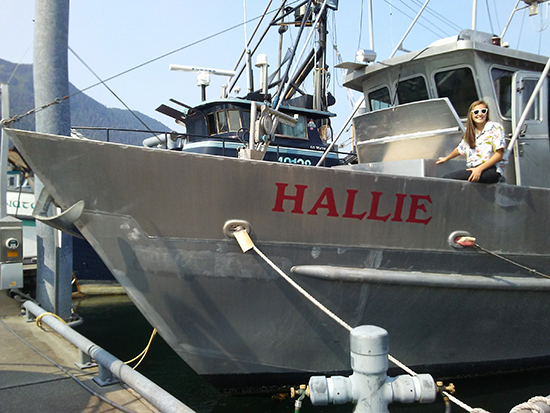CVM Student Spends Summer Working Aboard Alaskan Veterinary Boat

When Linda Buehler, a third-year veterinary student at the Texas A&M College of Veterinary Medicine & Biomedical Sciences (CVM), decided to visit her aunt and uncle in Alaska during the summer, she could only hope that there would happen to be a veterinarian with whom she could work.
Luckily, Petersburg, a small town of 3,000 people, has Dr. Ken Hill, the owner of Waterways Veterinary Clinic, who invited Buehler not only to work in his clinic for several weeks, but also to travel with him on the M/V Hallie, a fishing boat re-designed as a mobile veterinary clinic.
For one week, Hill, Buehler, and a veterinary assistant visited Zarembo Island and Wrangell Island in Southeast Alaska to provide veterinary care to animals owned by people who live in those remote areas. Working on a boat may be a regular activity for Hill and his staff, but it was a new and exciting experience for Buehler.
“You have to be very adaptive (on the boat),” she said. “It was supposed to double as the appointment room and surgery suite, but we ended up taking off all of the appointment supplies and just doing the entire appointment on the dock because it’s easier than getting dogs into the boat.”
Though exam tools were easily moved, the team still needed the sterile environment in the boat for surgeries.
“Surgery was interesting because it was really tight quarters,” Buehler said. “You would have three people, plus a dog, with the table down, and no room to move, so you had to have out everything you needed for the surgery, as well as backup supplies in case something went wrong.”
Luckily, they were always stationed in harbors with calm waters, so they didn’t have to worry about the boat rocking in the middle of a procedure.
The people on the Alaskan islands Buehler visited have no access to regular veterinary care unless they pay the expenses to travel by boat or plane to a nearby city, so Hill and his staff make regular trips on the M/V Hallie, while also offering phone consultations between visits.

“I wasn’t aware of how limited veterinary care is in Alaska,” Buehler said. “The biggest thing that’s been on my mind is, ‘They need more care in these remote areas,’ which is a problem, too, in rural areas of Texas, but at least here you can drive.”
When not on the boat, Buehler worked in the clinic by assisting in surgeries, giving input on physical exams, and taking every opportunity she got to learn from Hill and the other veterinary staff members.
“For every patient that came in, Dr. Hill would go over the physical exam and do more of the communication stuff, then I would come in and also listen to the heart,” Buehler said. “He would normally ask me, ‘What do you hear?’ or ‘What would you diagnose this as?’
“Then anytime that he got results back he would always have me look at them and say, ‘What would you tell the owner if this was your patient?’” she said.
Buehler was also able to learn about procedures she had never seen while working in Texas clinics, such as how to remove porcupine quills.
“I had never seen a porcupine in real life but that happens all the time there. Dogs chase porcupines and get quills everywhere, and then they try to paw them out and quills get stuck in their paws,” she said.
“Removal is really simple; the dog is sedated and then you pull out the quills, just straight out, like how they went in,” Buehler said. “So, overall, it’s nothing too intense. But, it was interesting to see, even if it’s not necessarily a skill I’m going to use in Texas.”
Though the clinic is better equipped than the boat, it still has fewer resources than Buehler was used to. Most samples are sent away for testing by airplane and any animals needing x-rays must be taken to the local human hospital.
However, the reduced resources do not have any negative impact on the clinic’s veterinary team, who have developed ways to work around their limitations and still provide patients with the best care possible.

“We hardly had any stressed patients,” Buehler said. “They were normally happy to be there and just super calm. So that was one thing that I really appreciated. I hope to get that in whatever clinic I’m working at in the future.”
Buehler grew up in Dallas, but has lived all over the world and plans to spend her veterinary career working in new locations, possibly even Alaska one day.
She is still deciding whether to pursue private practice or focus on a career in epidemiology and public health, which she developed a passion for while earning her undergraduate degree at Texas A&M in applied mathematics with a biology track.
In the meantime, Buehler plans to gain more mentorship and experience in veterinary medicine and hopes to serve as a relief veterinarian at Waterways Veterinary Clinic during the summers. She looks forward to returning to Alaska both to practice veterinary medicine and to see more of the beautiful scenery and wildlife.
“I saw some black bears, a lot of porcupines, humpback whales, seals, and sea lions,” she said. “I went kayaking one day and a seal came up right next to us; it was crazy. It was really cool to see and really unexpected, so it kind of scared me a little bit!
“Being in Alaska definitely put the idea of living in Alaska more of an option than it would’ve been before the summer,” she said. “I think it would be a fun place to live. I really like the work-life balance, the atmosphere, and the people there. The sense of community is definitely something I’m looking for in my life.”
###
For more information about the Texas A&M College of Veterinary Medicine & Biomedical Sciences, please visit our website at vetmed.tamu.edu or join us on Facebook, Instagram, and Twitter.
Contact Information: Jennifer Gauntt, Interim Director of CVM Communications, Texas A&M College of Veterinary Medicine & Biomedical Science; jgauntt@cvm.tamu.edu; 979-862-4216


